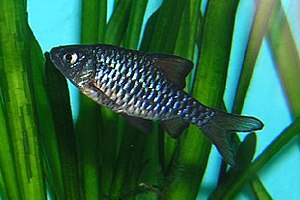Island barb
| Island barb | ||||||||||||
|---|---|---|---|---|---|---|---|---|---|---|---|---|

Island barb ( Oliotius oligolepis ) |
||||||||||||
| Systematics | ||||||||||||
|
||||||||||||
| Scientific name of the genus | ||||||||||||
| Oliotius | ||||||||||||
| Kottelat , 2013 | ||||||||||||
| Scientific name of the species | ||||||||||||
| Oliotius oligolepis | ||||||||||||
| ( Bleeker , 1853) |
The checker barb ( Oliotius oligolepis , Syn. : Puntius oligolepis ) is a small fish from the family of carp fish . It occurs in Sumatra ( Indonesia ) in herbaceous streams and rivers and in the shores of lakes with dense vegetation. The species epithet oligolepis refers to the few, large scales of the species ( Greek oligo "little", lepis "scale").
features
The island barbel becomes five centimeters long. It has a typical barbel shape and is moderately elongated. The only dorsal fin is supported by four to eight fin rays, the anal fin by three to five. The pelvic fins are supported by a fake hard ray and seven to eight soft rays. The color of the Eiland barb is variable, red-brown to ocher-brown, also greenish or with a bluish pearlescent sheen . Each individual scale is patterned, has a bluish spot at the base and a black border. In the slimmer males the unpaired fins are reddish to brick-colored and have a black border, in the females they are without a border and ocher yellow.
The Eiland barbel differs from other Southeast Asian barbs formerly assigned to Puntius by its unique color pattern consisting of crescent-shaped, black arches on each scale and its large scales with 17 scales in a central longitudinal row and 8 around the tail stalk. In a transverse row between the base of the dorsal fin and the center line of the abdomen, count ½3 / 1 / 3½ scales in front of the base of the ventral fin. The sideline is incomplete and extends over 6 to 7 scales with pores. The last unbranched dorsal fin ray is unsawed. Rostral barbels are absent, maxillary barbels are present. The lips are smooth and thin. Rows of small papillae are found on the sides of the snout, in the eye region, on the gill cover and on the “throat”. These rows of papillae are absent from all other Southeast Asian barbels with the exception of Striuntius . On the first gill arch there are 3 to 5 gill rakes .
Reproduction
Island barbs spawn freely in delicate aquatic plants. Around 300 eggs are released per clutch. The fry hatch after 36 to 48 hours.
Systematics
The island barbel was described in 1853 by the Dutch doctor and ichthyologist Pieter Bleeker as Capoeta oligolepis , later assigned to the collective genus Puntius . In November 2013, the Swiss ichthyologist Maurice Kottelat assigned them to the newly established monotypical genus Oliotius, which was specially created for the island barbel . The generic name was composed of one part each of the species epithet oligolepis and one from Puntius .
Aquaristics
The island barbel is an undemanding freshwater ornamental fish , of which there is also an albinotic breed. A wild population has developed from released aquarium fish in Colombia .
literature
- Günther Sterba : The world's freshwater fish. 2nd Edition. Urania, Leipzig / Jena / Berlin 1990, ISBN 3-332-00109-4 .
- Hans A. Baensch & Rüdiger Riehl : Aquariums Atlas, Volume 1 . Mergus Verlag, 1997, ISBN 3-88244-101-1 .
Individual evidence
- ↑ a b Maurice Kottelat: The fishes of the inland waters of Southeast Asia: A catalog and core bibliography of the fishes known to occur in freshwaters, mangroves and estuaries. ( Memento of the original from January 6, 2015 in the Internet Archive ) Info: The archive link was automatically inserted and not yet checked. Please check the original and archive link according to the instructions and then remove this notice. (PDF; 6.6 MB) The Raffles Bulletin of Zoology, November 2013, Supplement No. 27, page 483.
Web links
- Eilandbarbe on Fishbase.org (English)